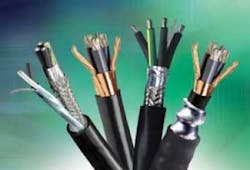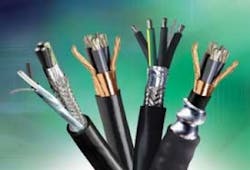Robust Cabling Key to Reliable VFD AC Motor Control
By Brian Shuman
Classic Design VFD cables
Classic Design VFD cables (16 to 2 AWG) offered by Belden Inc. feature the company’s Beldfoil® foil plus TC braid shield which provides the lowest resistance path to ground to improve common mode current containment. This dual shielding offers 85 percent braid coverage and 100 percent foil coverage to provide protection from both radiated and conducted noise.
The company’s Symmetrical Design VFD cables (16 to 4/0 AWG) are designed for use with larger, more powerful AC motor drives. They feature dual spiral copper tape shielding offering 100 percent coverage. These shields also provide a low resistance path to ground, as well as improved flexibility and highly effective noise protection. The cables’ three symmetrical bare ground wires provide a balanced ground system, which reduces AC motor shaft voltage to avoid the likelihood of premature bearing or motor insulation failure.
Belden VFD cables are appropriate for use with AC drives manufactured by Rockwell Automation, AA Electric, ABB, Baldor, General Electric, Hitachi, Magnetek, Siemens and other leading drive manufacturers.
Variable Frequency Drives used to control motor speed and torque in water industry equipment are subject to voltage spikes, acoustic motor noise, motor heating and other conditions that can damage equipment and have a negative effect on operational efficiency. Voltage spikes, for example, can cause corona discharges to occur within motor windings, causing damage not only to the cabling that supports the equipment, but also to the motors, bearings, and drives. This damage can result in failure of the entire VFD system, resulting in costly production downtime.
Belden Inc. offers a full line of VFD cables designed specifically for AC motor drive applications. Both the Classic Design and Symmetrical Design VFD cables offer robust construction plus a high level of shielding to protect surrounding equipment and instrumentation from voltage spikes and radiated noise.
Choosing the right industrial-grade cabling can overcome these hazards, making VFDs a safe and sensible investment. However, it is important to ensure that the VFD cables selected are reliable and rugged enough to handle the high degree of humidity, grit and sludge present in water treatment facilities.
Cable Selection
In general, cable selection will depend on the specific application requirements, relative to motor size in HP, speed and torque demands of the load, and peak current. Also to be considered are the environmental conditions of the installed site. A cable should never be the weak link in a VFD system. The cables selected must have the ability to withstand the harshest operating conditions in order to maintain the life of the other system components.
Industrial-grade VFD cabling provides the strength, flexibility and signal integrity that traditional cabling does not provide in extremely harsh operating conditions. And, by mitigating the harmonics generated by VFDs during operation, the cable can help to improve overall drive system reliability and longevity.
There are several reasons why special attention should be paid to making sure that the VFD cable is equipped with the best possible insulation material, and an effective impedance and shielding/grounding system. These include:
- Stable electrical performance. Cables employing a heavy wall of thermoset insulation are recommended. Thick, industrial-grade XLPE insulation provides more stable electrical performance than PVC and makes the cable more immune to failure from reflected wave, corona discharge and voltage spikes. It also delivers lower capacitance which allows for longer cable runs and results in reduced peak motor terminal voltage for extended motor life and increased efficiency of power transfer.
- Mitigation of radiated and common mode noise. Radiated noise and common mode noise are typical with VFD systems. Noise radiated from a VFD cable is proportional to the amount of varying electric current within it. As cable length grows, so does the magnitude of reflected voltage. This transient over-voltage, combined with the high amplitudes of current associated with VFDs, creates a significant source of radiated noise, which can be a source of interference with adjacent systems. The solution to mitigating radiated noise is to ensure that the cables incorporate highly protective shielding.
Common mode noise is another challenge in which high levels of noise across a broad frequency range, often from 60 Hz to 30 MHz, can capacitatively couple from the windings of the motor to the motor frame, and then to ground. Common mode noise can also capacitatively couple from unshielded motor leads in a conduit to ground via ground straps, supports, or other adjacent, unintended grounding paths. This can be particularly troublesome because digital signals, such as those from proximity sensors, thermocouples or encoders, are susceptible to the high-frequency noise generated by VFDs.
One way to ensure mitigation of both radiated and common mode noise is to select cables with a properly designed cable ground/shield system. And, when VFD cables are installed in close proximity to low-level communications cables and other susceptible devices, shielded instrumentation cable should also be used. It is also prudent to limit the run of a VFD cable parallel to instrumentation cables to 10 ft or less to reduce the likelihood of radiated noise issues.
Additional features to look for in industrial-grade VFD cabling include:
- High-strand tinned copper circuit conductors, which provide better vibration resistance and greater flexibility for easy installation
- Sunlight- and oil-resistant PVC jacketing
Continuous armoring might also be recommended for use in extremely harsh environments because of the low impedance path they provide for common-mode noise to return to the drive.
And finally, check with the manufacturer to ensure that the VFD cables selected have been tested and certified to fully comply with all industry certifications and safety standards appropriate for the specific VFD equipment, application and/or installation site.
Given the demanding environmental and operating conditions in water and wastewater treatment plants, it’s easy to see why high quality VFD cables are so critical to the success of a Variable Frequency Drive system. Yet, investment in VFD technology has proven time and again to pay off – often dramatically – in terms of reducing energy use and costs, cutting carbon emissions, and extending the service life of costly capital equipment.
About the Author: Brian Shuman, RCDD, is a Senior Product Development Engineer for Belden Inc., a provider of cabling, connectivity, switches, hardware and cable management solutions for a wide range of markets, including industrial, enterprise networking, broadcasting, audio/video, security and more. For more information on Belden’s VFD solutions for the water and wastewater treatment industry, and to download the company’s Water/Wastewater Solutions brochure, Product Bulletin and technical white paper, visit www.belden.com/industrial.

